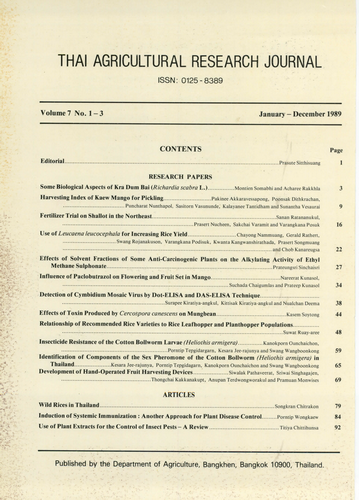Relationship of Recommended Rice Varieties to Rice Leafhopper and Planthopper Populations
Abstract
Outbreak of leafhoppers (LH) and planthoppers (PH) are frequently encountered in the four recommended high yielding rice varieties RD 7, RD 11, RD 21 and RD 23. Using these varieties, populations were monitored under both laboratory and field conditions for green leafhopper – GH (Nephottetix virescens), the zigzag leafhopper (Recillia dorsalis), the brown plant hopper – BPH (Nilaparvata lugens) and the white backed plant hopper- WBPH (Sogatella furcifera). The field studies were undertaken in the Pathum Thani and Chachoengsao areas in the Central Plains Region during the dry and wet seasons of 1987 and 1988.
Generally LH population grown was lower than that of PH. The increase in population of BPH in 10 and 30 day old rice plants of RD 7, RD 11 and RD 21 was higher than for RD 23. However, WBPH populations were found to be highest on RD 23. Under field condition both GLH and BPH populations were high, with peak populations during the booting and heading stages of plant development. Generally both LH and PH populations were high on RD 7. The stability of LH and PH communities as measured by the diversity index, was found to be higher on RD 23 than on RD 7. The results indicated that in areas with endemic and severe outbreaks of LH and PH, the variety RD 23 should be preferentially cultivated. Greatest attention by farmers to the crop should be given during the booting and heading stages when peak populations of GLH and BPH are always found.
Downloads
Published
How to Cite
Issue
Section
License

This work is licensed under a Creative Commons Attribution-NonCommercial-NoDerivatives 4.0 International License.
Thai Agricultural Research Journal



